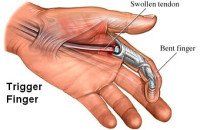Trigger Finger
Trigger Finger is a condition in which one or more fingers experience a “locking” or “catching” sensation when the digit is bent. As it is bent, the finger may or may not be able to re-open to its natural position.
The dominant flexor tendon that initiates finger movement passes through a natural type of “pulley system” formed along the finger. Normally, movement of this tendon along the tight-fitting pulley system occurs smoothly when bending a finger. Over time, or due to an injury, the tendon sheath can become swollen due to inflammation or irritation, and sometimes a nodule on the tendon can also develop.
As the swollen area of the tendon moves through the natural pulley system, it can become momentarily stuck in a position called triggering. The hesitated movement of the tendon can sometimes be accompanied by a clicking noise. In severe cases, the swollen tendon will barely pass through the pulley system, but it is unable to return back to its normal position. This causes the finger to become stuck in a flexed (bent) position.
The exact cause of Trigger Finger is not well understood. While injuries to the fingers, repetitive motion, and overuse of the fingers can cause triggering, arthritis sufferers commonly experience this condition as well.
Physicians will often treat this condition with anti-inflammatory medications or injections. Hand therapy utilizing a variety of exercises and modalities is often successfully used to reduce tendon inflammation and increase function in the hand.
In severe cases, minimally-invasive surgery to release some of these natural pulley structures and allow the inflamed tendon to glide more freely has had highly successful results. Hand therapy may be prescribed after the surgery to help restore range of motion, strength, and function to the area.
MEDICAL DISCLAIMER: The information contained in this website is intended for informational and educational purposes only. You should always with your physician for the diagnosis and treatment of any injury or condition. The content on this web site is general in nature and not complete, and it should never be used for diagnostic or treatment purposes.
